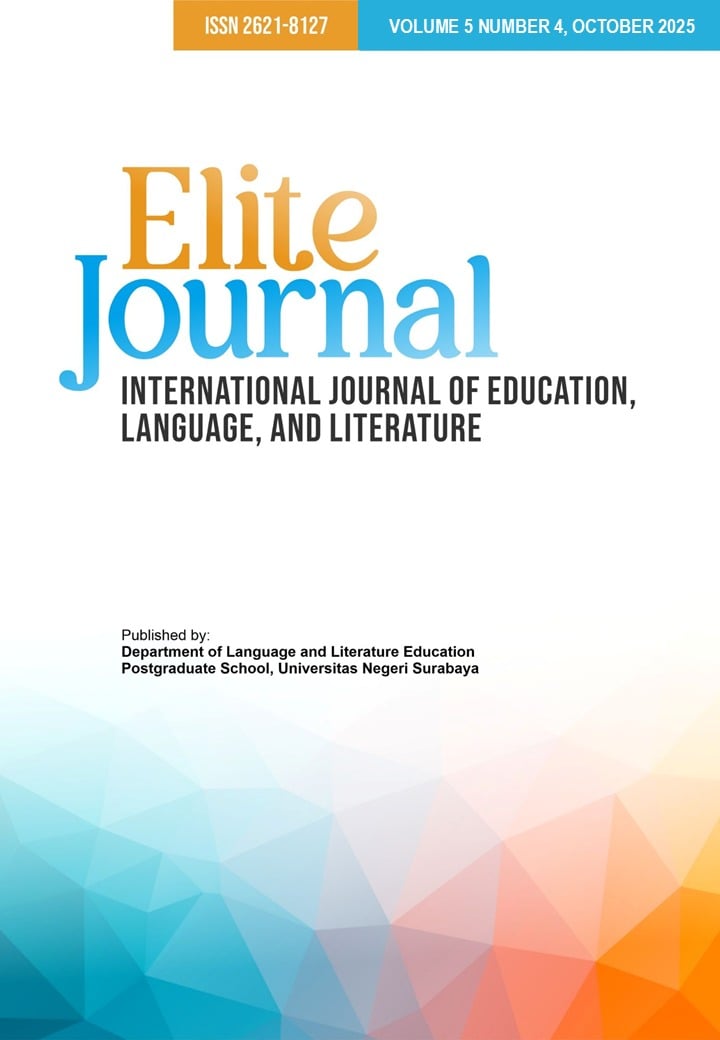AUDIENCE ENCODING-DECODING ANALYSIS IN TIKTOK’S DARK ROMANCE CONTENT
DOI:
https://doi.org/10.26740/elitejournal.v5n4.p18-31Keywords:
Audience Responses, Encoding-Decoding, TikTok, ViolenceAbstract
This study analyzes how audiences respond to violent portrayals in dark romance content on TikTok using Stuart Hall’s (1980) encoding-decoding theory as the main framework. Audience reactions are categorized into three positions: dominant-hegemonic, negotiated, and oppositional. The data consists of five selected TikTok posts under the hashtag #darkromance, with the three most-liked comments from each post (fifteen in total) examined through qualitative content analysis. The focus of the analysis is on textual elements such as captions, hashtags, and written comments, supported by visual cues when relevant. The findings reveal that audience responses vary depending on how the content is framed and what narrative style is used. When violent themes appear in book-promotional posts, audiences more often adopt an oppositional stance, expressing disapproval or discomfort. In contrast, the same themes packaged as fantasy or POV-style content are more likely to be accepted, generating dominant-hegemonic reactions. Among the 15 analyzed comments, eight reflect oppositional positions, five are dominant-hegemonic, and two are negotiated. Interestingly, oppositional comments received the highest number of likes, suggesting that a silent majority may support these critical views even if they are not the loudest voices. Overall, this study highlights that TikTok users are not passive content consumers but active meaning-makers whose responses are shaped by context and content framing. It is recommended that future research expand this topic by incorporating audio elements, conducting interviews with audiences and creators, or exploring similar phenomena on other new media platforms to gain a deeper and more comprehensive understanding.
References
Alley, A., & Hanshew, J. (2022). A long article about short videos: A content analysis of U.S. academic libraries’ use of TikTok. The Journal of Academic Librarianship, 48(6), 102611. (Elsevier/Scopus). ScienceDirect+1
Ceci, L. (2024, November 12). Number of TikTok users worldwide from 2020 to 2025. Retrieved February 12, 2025, from https://www.statista.com/statistics/1327116/number-of-global-tiktok-users/#statisticContainer
Dera, J. (2024). BookTok: A Narrative Review of Current Literature and Directions for Future Research. Literature Compass. (Wiley/Scopus). Compass
Dipsea. (2024, May 15). What is dark romance? Tropes, trigger warnings, and book recs. Retrieved February 12, 2025, from https://www.dipseastories.com/blog/what-is-dark-romance/
Fletcher, L., Driscoll, B., & Wilkins, K. (2018). Genre Worlds and Popular Fiction: The Case of Twenty-First-Century Australian Romance. The Journal of Popular Culture, 51(4). https://doi.org/https://doi.org/10.1111/jpcu.12706
Fortune, T. (2024). Rape Beyond Fantasy: Exploring the Influence of BookTok’s Rape Beyond Fantasy: Exploring the Influence of BookTok’s Erotica and Dark Romance Literature on Young Adult Perceptions Erotica and Dark Romance Literature on Young Adult Perceptions of Consent and Boundaries of Consent and Boundaries. https://digscholarship.unco.edu/theses/336
Google Play Store. (n.d.). Retrieved February 12, 2025, from https://play.google.com/store/apps/details?id=com.ss.android.ugc.trill&hl=en
Hall, S., Hobson, D., Lowe, A., & Willis, P. (1980). Culture, Media, Language (1st ed.). Routledge. https://doi.org/https://doi.org/10.4324/9780203381182
Hernandez, J. (2024). Exploring Consent: An Analysis of Consent in Dark Romance and Contemporary Romance Books. https://doi.org/https://archives.pdx.edu/ds/psu/42463
Lee, J. (2023). Introduction to the Special Issue of “TikTok and Social Movements.” Social Media + Society. (SAGE/Scopus). SAGE JournalsESPACE
McLuhan, M. (1964). Understanding media: the extensions of man. [1st ed.] New York, McGraw-Hill.
Merga, M. K. (2021). How can BookTok on TikTok inform readers’ advisory services for young people? Library & Information Science Research, 43(2), 101091. (Elsevier/Scopus). ScienceDirectResearchGatero.ecu.edu.au
PYKE, L. (2024). Immersive New Media And Abuse: Should There Be Regulations For How Interpersonal Abuse Is Broadcasted In Online Media?.
Rosanes, B. (2024, May 14). Hello, You: The obsession and consequences of dark romance. Retrieved February 12, 2025, from https://thebadgeronline.com/2024/05/hello-you-the-obsession-and-consequences-of-dark-romance/
Shahwan, S. J. (2023). The Impact of Social Media on Literature. Arab World English Journal, 1. https://doi.org/10.24093/awej/comm1.18
Widodo, J. S. (2022). Reception analysis of Indonesian audience towards physical and verbal violence on series Squid Game (2021) by Hwang Dong-Hyuk. Rainbow : Journal of Literature, Linguistics and Culture Studies, 11(1). https://doi.org/10.15294/rainbow.v11i1.53347
Zeng, J., Abidin, C., & Schäfer, M. T. (2021). Research Perspectives on TikTok and Its Legacy Apps (Introduction). International Journal of Communication, 15. (IJoC/Scopus). International Journal of Communication
Downloads
Published
How to Cite
Issue
Section
License
Copyright (c) 2025 Anisah Nur Fathimah

This work is licensed under a Creative Commons Attribution 4.0 International License.
 Abstract views: 193
,
Abstract views: 193
, PDF Downloads: 154
PDF Downloads: 154





